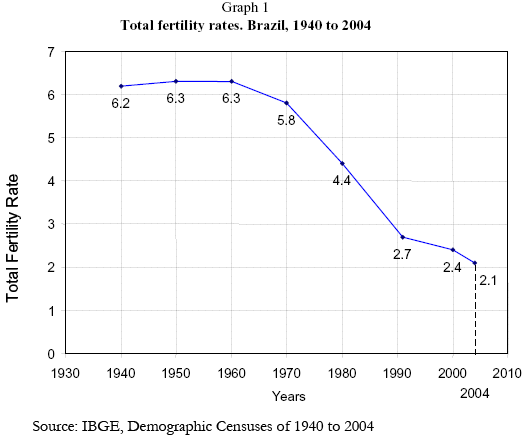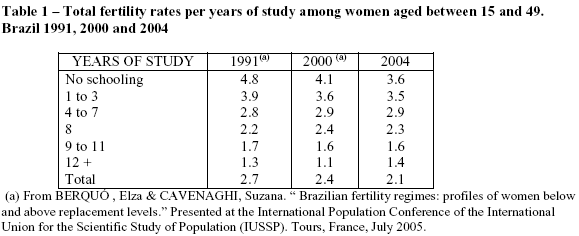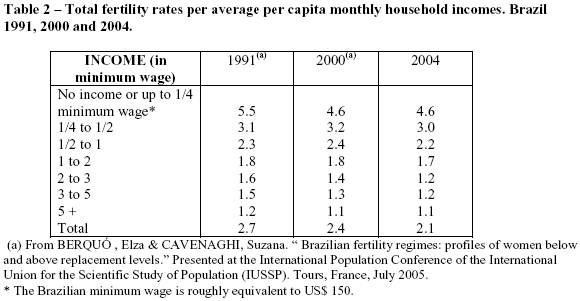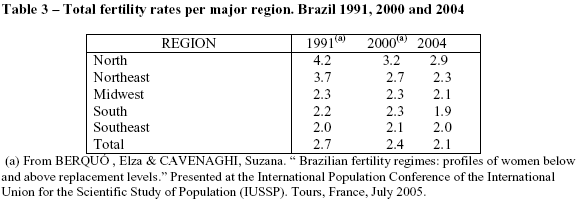Mi SciELO
Novos Estudos - CEBRAP
versión impresa ISSN 0101-3300
Novos estud. - CEBRAP v.2 n.se São Paulo 2006
Fertility in decline: a brief note on the decrease in the number of births in Brazil
Fecundidade em declínio: breve nota sobre a redução no número médio de filhos por mulher no Brasil
Elza Berquó; Suzana Cavenaghi
Translated by Anthony Doyle
Translation from Novos Estudo - CEBRAP, São Paulo, no.74, p.11-15, Mar. 2006.
SUMMARY
This article analyses data on fertility in Brazil from the 2004 National Household Sample Survey, which confirmed a downward trend in the number of births per woman. The expectation is that the next few years could see a decrement in the least privileged segments of the population, responsible for the most expressive drops in the average number of children per woman.
Key words: NHSS 2004; fertility; demographics; population.
RESUMO
Este artigo analisa os dados sobre fecundidade no Brasil apresentados na PNAD 2004, que confirmou a tendência de queda no número de nascimentos. Sustenta-se que, nos próximos anos, reduções possam ocorrer nos segmentos menos favorecidos da população, responsáveis pelas mais expressivas quedas no número médio de filhos por mulher.
Palavras-chave: PNAD 2004; fecundidade; demografia; população.
The level of fertility of a nation is part of a series of indicators that guides public policymakers; given the implications a birthrate below the replacement level (an average of 2.1 children per woman) could have on decreasing population rate of growth and on aging. Conversely, a high birthrate could indicate a lack of public access to information and services in reproductive health.
As already known, the transition in fertility in Brazil began in the mid-1960s. The birthrate dropped 24.1% between 1970 and 1980, by 38.6% the following decade and by 11.1% from 1991 to 2000 (Graph 1).

Berquó & Cavenaghi1 demonstrated that the fall in fertility rates between 1991 and 2000 was not uniform across the various socio-demographic segments of the population. Important differences were identified, revealing that the sharpest drop occurred among groups which had shown the highest levels of fertility in 1991, namely poorer, less educated, predominantly black women from rural areas of the North and Northeast.
The 2004 National Household Sample Survey confirmed the downturn in birthrate, which slumped to its all-time low in recent years. The average number of children per woman was 2.1, down 12.5% on the last census. A Schooling and income remained negatively correlated with fertility2. Table 1 crosses fertility vs. years of schooling and shows that, in 1991, women who never attended school had an average of 3.5 more children than those with 12 + years of study. By 2000, this difference had slipped to three children, eventually sliding to 2.2 in 2004. Table 1 also shows that the decreases during the period 1991-2000 were mostly due to the lower childbirth rates identified among women with no schooling: 14.6% between 1991 and 2000 and 12.2% from 2000 to 2004.

However, if we compare average per capita household incomes for 1991, we see that the poorest women had an average of 4.3 children more than women at the extreme upper end of the incomescale (Table 2). The gap narrowed in 2000 and 2004, but is still in the order of 3.5 children. Onceagain, the decline observed between 1991 and 2004 was largely due to the decreased fertility rate(in the region of 16.4%) among poorer women.

An urban or rural household setting was another key differential in womens fertility regimes. In 1991, women from rural Brazil had 4.3 children on average, i.e. two more than their urban counterparts. Though this difference had narrowed to 1.2 children ten years later, it remained unchanged in 2004.
The decrease observed in rural Brazil during the period 1991-2000, from 4.3 to 3.4 children per woman (a drop of 20.9%), was largely responsible for the overall nationwide decrease for the same period, as urban fertility rates stuttered from 2.3 to 2.2, a mere 4.3% reduction. A comparison of the data for 2004 with that for 2000 reveals that the fall is continuing, in both urban and rural Brazil. Cities and towns have already reached a fertility average of 2 children per woman – which is below the replacement level.
Regional comparisons still display important differences, as can be seen from Table 3. In virtue of their higher rural contingents and less favourable socio-economic indicators, the North and Northeast have the highest fecundity rates in the country. Nevertheless, we must note that it was these two regions that registered the sharpest decrements in average number of children per woman during the period 1991-2004 – in the order of 31% and 37.8% respectively.

Despite the abiding differences and the co-existence of various fertility regimes throughout the country, what we can see is a systematic decrease in the percentage of women aged between 15 and 49 years with five children or more and an increase in the number of women showing a fertility rate below the replacement minimum (Table 4). Indeed, the number of women in the high fertility level group shrank from 11.1% in 1991 to 4.1% in 2004.

In numbers, this amounts to approximately two million women of reproductive age, compared with four million in 1991. On the other hand, the number of women of reproductive age living in low fertility regimes rose from 45.3% in 1991 to 53.6% in 2004. Otherwise put, in 2004 there were 26.2 million women of reproductive age having a maximum of two children each, compared with the corresponding 16.6 million in 1991.
This brief panorama of the decrease in fertility leads one to suppose that the coming years could see a decrement within the least privileged segments of the population, responsible for the largest differentials and the most expressive drops in the average number of children per woman.
Received for publication on March 24, 2006.
Elza Berquó is a researcher at the Núcleo de Estudos de População (NEPO/UNICAMP) and coordinator of Cebraps Population and Society department. Suzana Cavenaghi is a researcher at the Escola Nacional de Ciências Estatísticas do IBGE.
1 BERQUÓ , Elza & CAVENAGHI, Suzana. Brazilian fertility regimes: profiles of women below and abovereplacement levels. Presented at the International Population Conference of the International Union for the Scientific Study of Population (IUSSP). Tours, France, July, 2005.
2 It is worth remembering that fertility trends per income category have to factor-in changes in the womens economic conditions over the course of the decade. The same is also true, though to a lesser degree, of changes in educational structure, as, unlike income, a womans number of school years can only increase over time.













